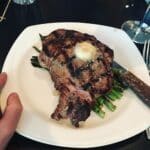Summary of PodcastOne: Dr. Gundry’s Quick Health Tip: EAT THIS FOR YOUR ONE MEAL A DAY WHEN FASTING:
Dr. Gundry advocates fasting and emphasizes that what you consume during fasting is as significant as the duration. He shares his one meal a day option and the advantages of following this fasting method.
*****
One Meal A Day Fasting? Here’s What Dr. Gundry Eats!
Fasting has been a hot topic in the health and wellness industry for quite some time now. However, it can still be confusing for many of us who are new to it. And while there are different types of fasting techniques out there, Dr. Steven Gundry, a renowned heart surgeon, and health expert, has been advocating for the benefits of one meal a day (OMAD) fasting.
The Benefits of OMAD Fasting
The idea of OMAD fasting is to have one large meal during the day and then fast for the remaining 23 hours. This technique has shown to have numerous benefits, including weight loss, improved mental clarity, increased energy levels, and reduced inflammation. When we fast, our bodies switch from glucose to ketones as its primary source of energy. And this metabolic shift allows our bodies to burn stored fat for fuel, leading to weight loss.
Moreover, fasting can increase our lifespan! It activates a process called autophagy, which is the body’s way of cleaning up damaged cells and promoting cell regeneration. It also helps to balance insulin levels, reduce inflammation, and lower the risk of chronic diseases such as diabetes, heart disease, and cancer.
What Does Dr. Gundry Eat During OMAD Fasting?
If you’re considering trying OMAD fasting, you might be wondering what to eat during your one meal a day. Dr. Gundry, a staunch advocate of plant-based diets, recommends consuming high-fiber, low-carb, and protein-rich meals.
One of Dr. Gundry’s favorite meals to break his fast is a big salad filled with lots of leafy greens, broccoli, cauliflower, onions, and avocado. He also recommends adding healthy fat sources like nuts, seeds, and olive oil. For protein, he suggests eating grilled wild-caught fish or pasture-raised chicken with a side of roasted vegetables.
However, Dr. Gundry emphasizes the importance of listening to your body and personalizing your meal according to your dietary restrictions and preferences. He also notes that consuming nutrient-dense foods such as berries, chia seeds, and quinoa can be beneficial during your one meal a day.
How to Practice OMAD Fasting
If you’re new to fasting, it’s best to ease into OMAD fasting gradually. Start with a 12-hour fast and gradually increase your fasting window over time. Keep in mind that OMAD fasting is not suitable for everyone, particularly those with a history of eating disorders, diabetes, or other medical conditions. As always, it’s essential to consult with your doctor before starting any fasting regimen.
During your eating window, make sure to consume enough calories to sustain your body’s needs. Don’t shy away from healthy fats, protein, and complex carbohydrates. And, most importantly, stay hydrated throughout the day by drinking plenty of water and herbal teas.
Final Thoughts
OMAD fasting can be a powerful tool for weight loss, increased energy, and overall health. However, it requires discipline and a willingness to listen to your body’s needs. It’s crucial to fuel your body with nutrient-dense foods during your one meal a day, like those that Dr. Steven Gundry recommends.
Remember, fasting is not a one-size-fits-all approach. Always consult with your doctor before starting any fasting regime and avoid fasting if you have a history of disordered eating or any medical conditions.

Comments are closed